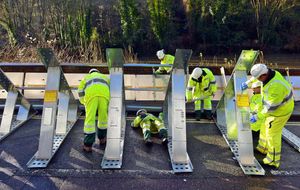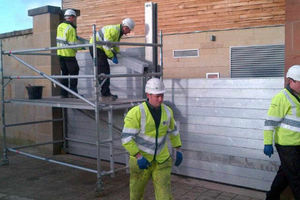Protecting Shropshire from floods - this winter cost £45,000 keeping our homes dry
Protecting Shropshire's homes from rising river levels this winter has cost around £45,000 so far, figures released today reveal.
But the Environment Agency says it is good value for money – because the average bill of a single home that is engulfed by water is around £50,000.
Officials say the portable barriers have transformed the way the River Severn is controlled during times of high rainfall.
And, while areas like the Lake District, Yorkshire and Scotland face a massive clean-up bill, floods in Shropshire have been managed to avoid damage.
Dave Throup from the Environment Agency today said the barriers have proved to be "worth their weight in gold".

He said: "It isn't just reducing the cost of claims because of floods, it's keeping towns open for business as well.
"If you had to close the Frankwell end of Shrewsbury it would be terrible for the town. In Ironbridge there's more of an impact when the barriers go up, but it still keeps the Wharfage open for people to visit."
The EA said costs can vary every each time the temporary defences are deployed, and depending on the type of defence used in a particular location.
But as a general rule for temporary barriers - not demountables - it costs between £5 and £10 per metre per deployment, plus additional costs for transport and de-construction.
The barriers have been assembled a number of times this winter, preventing the River Severn breaking banks in areas where is can affect homes and businesses.
Since November 17 the flood barriers have been deployed four times at Frankwell, once at Coleham Head and once in Ironbridge, costing thousands of pounds each time.
Mr Throup said: "This year from the flooding up north I think the average insurance claim has been £50,000, so every house that's flooded could cost that much, and so the costs of the flood defence scheme and putting the barriers up are well worth it.
"They do a fantastic job in Shrewsbury, and they're not intrusive on the town. They don't disrupt businesses and the lower level barriers can go up an stay there for some time without causing problems.
"Ironbridge is a lot bigger operation, but the threshold for deploying the barriers is also higher so they're not needed as often."

Column Head's barriers are cheapest to erect, but still cost at least £1,000 each time they are needed, while Frankwell's barriers can cost up to £10,000 each time they are used.
In Ironbridge, where the barriers stretch the length of The Wharfage, they can cost up to £20,000 per deployment.
And each deployment also takes time as vehicles are loaded with the barriers and transported to the site they are needed before being installed.
As an example, the installation of a 100 metre long, demountable flood protection wall with a distance between supports of three metres and a protection height of 1.2 metres should take eight workers about two hours to put up.
Dismantling the same system takes approximately twice as long, as it will also require cleaning after use.
Mr Throup said: "All of our flood barriers are on the Severn, which is good because it's a slow reaction river, so generally we get warnings that the river is going to rise to a level where we might need the barriers a good 36 hours ahead.
"When we first get the heads up then we start running computer models which take into account the level of the river, the amount of rain likely to go into it, and what level the river is likely to reach. We've got operational thresholds and if the river is going to go through that we have a discussion whether the barriers are going up. That happens quite regularly."
If flooding is likely, a team of workers is kept in standby 24 hours a day ready to turn out and install the barriers. The defences themselves, which are kept in Shrewsbury, are also preloaded on to lorries to save time if they are needed.
"We can be on site within an hour should we need to be," Mr Throup said.





